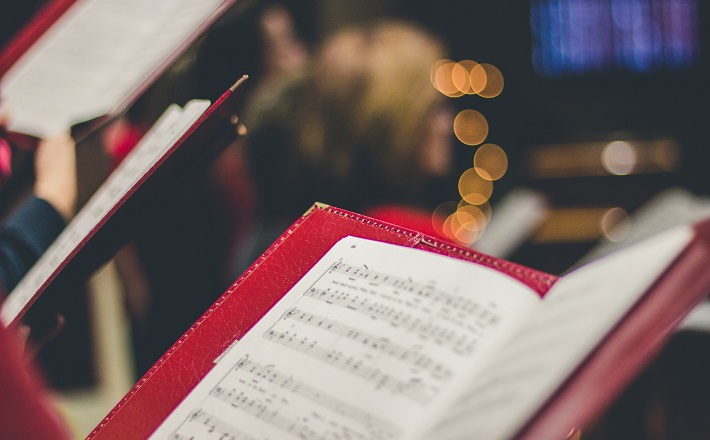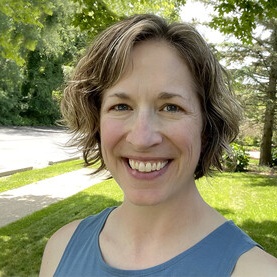Congregations love to sing the songs of our faith. But do we recognize this singing as proclaiming the Gospel? The Christmas season, especially full of familiar hymns, is a popular time for a service of lessons and carols as we try to pack in all of our favorites.
But what about other seasons of the church year? Bringing the theology of our hymns front and center—perhaps in a lessons and carols style service—can lift up the power of our faithful songs and the action of singing together, and give us words to share our faith in all seasons. Preachers may add context to highlight the Good News in the songs/hymns and the act of singing, or invite choir or congregation members to share reflections aloud or included in written form. Below are some ways to talk about why and practical suggestions for how to proclaim the Word in this way.
“It Is Well with My Soul”
Hymns are some of the first songs we learn to sing and the last songs we remember. We sing “Jesus Loves Me” to our babies as they fall asleep, and they begin to hum the tune while they play. When our elders can no longer speak our names, they can still sing “Amazing grace, how sweet the sound that saved a wretch like me.” Those words of John Newton are the gospel in a nutshell, proclaiming God’s grace to all who hear them. Hymns tell the stories of our faith, connecting us across time and space with the saints at rest. We can sing a hymn written centuries ago, using language that would sound arcane in present-day conversation, and find that the poet speaks to us in our modern context. Hymn writers interpret God’s word for us, recounting our story of salvation, proclaiming the good news. As we sing their songs, the Spirit creates faith in us.
“C(h)ords that Cannot Be Broken”
When we meet in corporate worship, we participate in a unique event that binds us together in ways that counter our individualistic culture. As we sing together, we begin to breathe together, our hearts begin to beat together. Our bodies sync up, and we become one voice. Science tells us that experiences like this increase the flow of endorphins and oxytocin, creating a sense of fellowship and empathy. “When done well, this kind of singing is capable of drawing the ill-tempered, bigoted, self-absorbed, and broken members of Christ’s global body into a harmonious whole that astonishes afresh both the doubter and the believer”(Taylor). In this way the act of singing itself is a proclamation of the Gospel. We are one Body in Christ, but need to experience it to believe it!
“How Can I Keep from Singing?”
In the primary hymnals of my church body, there are 900+ hymns. Even spreading those all out across three years’ worth of lectionary readings, we can’t sing them all. Any shorter season or one-day festival of the church year can provide an occasion for a service of lessons and carols—opportunity to sing more songs for a particular feast day. By contrast, some Sunday deep within ordinary time, perhaps when you need a reprieve from one more Sunday of preaching about bread, can also be an ideal time for this kind of service. Such a format is not a “get out of jail [preaching] free” card—rather, you may find that hymns breaking open the word provide nourishment to sustain many more weeks of sermons.
Whenever you decide to schedule a lessons and carols service, be sure to tell the whole story, choosing a variety of songs that guide us through the fall, the promise of the Messiah, and redemption. The traditional Christmas “Festival of Nine Lessons and Carols” or the readings used at Easter Vigil can serve as a template. Some hymns, like Martin Luther’s “Dear Christians, one and all, rejoice” and Paul Speratus’s “Salvation unto us has come,” contain the whole story within themselves.
“No Story So Divine”
The historical context of hymns can guide your pairing of lessons with particular songs. Information from these resources could also be offered as commentary alongside the scripture readings and songs.
- Hymnary, a “comprehensive index of hymns and hymnals,” is searchable by text, tune, writer, composer, hymnal, and lectionary. The site even has pdfs of the hymn as it appears in your hymnal, and midi files so that you can identify the correct tune.
- There are also denominational resources connected to some hymnals: Hymnal Companion to Evangelical Lutheran Worship (and soon also for All Creation Sings), Glory to God: A Companion (PCUSA), and the Companion to the United Methodist Hymnal. Indexes to Evangelical Lutheran Worship lists songs related to specific Bible passages.
- Other resources, like the Musician’s Guide and The Canterbury Dictionary of Hymnology, provide guidance for leading or performing hymns.
“Come, All You People”
A service of lessons and carols can take different forms and provide opportunities for collaboration. If you have music staff, you can work with them to choose Bible readings and songs. If you’re working with music volunteers, you could plan with a worship committee or invite a few congregation members interested in music. The format typically follows a Bible reading + hymn structure, but you could add a prayer after each hymn to draw on a theme in the text. Repeat this pattern as many times as you’d like—lessons and carols could be the entire service, or begin the service with this section and then transition to a communion service with intercessory prayers. Lessons and carols also allow for a variety of instrumentation and song leading, a chance to include children or youth who may be comfortable playing just a melodic line. Make it an occasion for intergenerational worship leading and music making, drawing on corporate worship’s unique ability to bring us all together, telling the story of the cross that has made us one.
“Just as I am, without one plea,
but that thy blood was shed for me,
and that thou bidd’st me come to thee,
O Lamb of God, I come, I come.”
– Charlotte Elliott, 1789–1871
Notes
- Taylor, W. David O. “Hymns and Neurons: How Worship Rewires Our Brains and Bonds Us Together,” Christianity Today, Aug 29, 2022.

